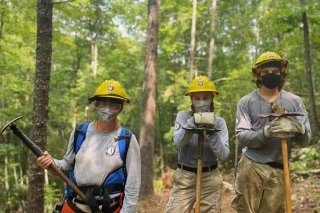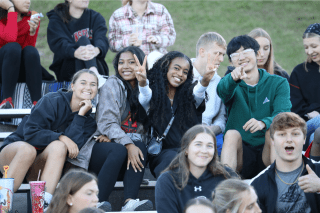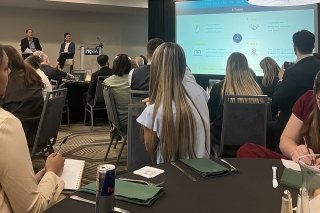Alumna making a difference with AmeriCorps
Bloomsburg
Posted
The average person probably wouldn't volunteer to fight a wildfire. Amanda Settembrino '19, a Bloomsburg geography and planning graduate, isn't average.

As high winds exploded the Caldor fire in Northern California across the Sierra Nevada Mountain range in 2020, many individuals would think twice to travel right into the center of the blaze in Lake Tahoe. However, there was no better time to be there for Amanda Settembrino ’19 and the other AmeriCorps National Civilian Community Corps (NCCC) Forest Team Delta 2 firefighters.
Originally from Glenside, Settembrino graduated from Bloomsburg University with a degree in environmental, geographical, and geological sciences (EGGS) with a concentration in geography and planning. Settembrino hadn't planned on graduating with her degree in geography and planning, but an environmental issues and choices class with Jennifer Haney, associate professor of EGGS, inspired her to change her major.
Settembrino joined AmeriCorps in 2020 at the start of the COVID-19 pandemic.
“My boyfriend, Kyle Halat, had done some work with the American Conservation Experience (ACE) and suggested I look into it,” said Settembrino. “He said it was a great opportunity to get more experience, especially in things like fieldwork.”
Settembrino began working with the Walker Basin Conservancy in Nevada, where she helped remove invasive plants and replace them with native ones. Her second position within AmeriCorps was in ACE with Pinnacles National Park in California.
Currently, Settembrino works in Mississippi doing prescribed burns. Settembrino got involved in the firefighting part of the organization while applying for a specialty team. Within Americorps NCCC, there are two types of specialty teams: construction and forest, which respond to wildfires.
After joining the forest team, Settembrino and her team were dispatched to South Lake Tahoe in California to respond to the Caldor fire. They drove across the country in four days to help. She and her team hiked through “the black” to find active fires and hotspots and extinguish them.
Of the two weeks that Settembrino fought the Caldor fire, she says that day 10 was the most memorable.
“On day 10, we found a burning tree that needed to be put out because it was surrounded by a lot of unburned fuel and we had to stop it from spreading. We had to call in a helicopter to drop water on it,” said Settembrino.
What surprised Settembrino most about firefighting was that you don’t have to be extremely fit to help on hand crew.
“As long as you try as best you can to stay fit, you’ll be fine. You don’t need to be incredibly muscular either,” said Settembrino, “However, if you want to be a hotshot crew member, that’s different.”
Eventually, Settembrino hopes to get a full-time job fighting fires, doing prescribed burns, or removing invasive species with the government after her time with AmeriCorps.



